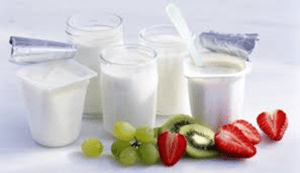Making yogurt, Cultured Buttermilk or Fermented Milk is a milk derivative, made through certain fermentation processes by adding some types of beneficial bacteria to milk.

Buttermilk has a sour, granular taste and is thicker than milk and lighter than yogurt, NanoPro, we provide consultancy services for industrial food businesses that produce at different scales.
Table of Contents
What is yogurt ? for Making yogurt
The health benefits of curd are numerous, and it is a good source of protein, calcium, and many nutrients for a healthy body. Health information is found in Food, Probiotics, Gastrointestinal, and Gastrointestinal.
Stages of making yogurt
Some types of yogurts contain live bacteria, or the so-called probiotic, which comes either as a part of the yogurt starter or is added after pasteurization and has many benefits for the body and in the process of digestion.
The important things to know in the manufacture of yogurt are the bacteria used in the manufacture of yogurt called the “yogurt culture” that ferments the sugar lactose (milk sugar), which is a natural sugar found in milk. The fermentation process produces lactic acid, a substance that leads to the coagulation of milk proteins, which gives milk Its unique flavor.
Yogurt production stages of Making yogurt
- Pasteurization Making yogurt
Making yogurt ,of milk by heating it for half an hour, at a temperature of eighty-five degrees Celsius, or it can be heated for ten minutes, provided the temperature is raised to ninety-five degrees Celsius, where it is taken into account at this stage that the heat treatment of milk prepared for the production of yogurt Higher and longer than in the case of pasteurized milk production, in order to reach a suitable environment for the work of the bacterial initiator, and to reformulate and precipitate whey proteins, thus giving the appropriate viscosity and texture to the coagulated milk.
Pasteurization is a heating process that eliminates harmful bacteria by heating milk to a certain temperature for a specified period of time. In other words, pasteurized milk is a form of milk that is heated to a high temperature in order to eliminate any harmful pathogenic microorganisms (e.g., E. coli, salmonella, and listeria) that may be present in the raw milk).
- Naturalization of milk in Making yogurt
- , which is the process that accompanies milk pasteurization, and the naturalization process aims to prevent the formation of a cream layer on the face of the yogurt during the incubation process when keeping it in the refrigerator and to improve the texture of the yogurt. It aims to break up fat granules to work on their spread and prevent their escalation on the surface. At the present time, the process of naturalization is one of the steps of the industry in many dairy products, but mostly such as pasteurized and sterilized milk. Inside the yogurt industry.
- Put the milk into the manufacturing barrel; Then cool it to the temperature suitable for the action of the bacterial initiator, which is 43 ° C.
- Add the bacterial initiator at 2% to the milk, then run the stirrer for five minutes so that the bacterial initiator is well distributed.
- Transfer the milk to the filling machine immediately, to be filled in suitable containers according to the desired size.
- Filling yogurt containers in plastic boxes.
- Transfer the boxes directly to the incubation room, taking into account that the room temperature is equal to 43 degrees Celsius and that the room has fans to distribute hot air in the room to ensure that the temperature reaches all the boxes, and this process is to incubate the yogurt packages and takes a time ranging from three to five hours Without moving it to complete the fermentation process and the clot is formed.
- Transfer the yogurt packages to the refrigerator, to cool them at an appropriate temperature – usually five degrees Celsius – after which they are ready for marketing to consumers.
Good Yogurt Qualities
Yogurt is one of the milk that is used frequently by young and old, and it is in great demand because it contains many benefits, especially calcium, which is necessary for the human body. Among the qualities of good yogurt are:
- It should be in good shape
- It should be soft to install
- It should be homogeneous and of acceptable taste
- Its smell should be acceptable and not excessive in acidity
- That the texture is coherent and homogeneous
Yogurt types
In addition to the components of yogurt, there are different types of it, which are as follows:
- Skimmed or low-fat yogurt: Yogurt made from skim milk.
- Kefir: It is a liquid yogurt that is drunk and is the result of the fermentation of milk by bacteria with yeasts.
- Greek Yogurt: This type of yogurt is thick and creamy
- Yogurt fortified with beneficial bacteria: It is a type of yogurt that is fortified with probiotic bacteria that are beneficial to the human body
- Yogurt with different flavors of fruits: It is a type of yogurt that is flavored with fruits such as banana flavored yogurt or strawberry flavored yogurt
Problems and defects that accompany the manufacture of yogurt (yoghurt)
Among the defects and problems facing the yogurt industry, which are one of the main problems for owners of food factories, which we will mention below
- Highly acidic taste
- Not enough acidity
- Weak clot
- Absence of yogurt taste and flavor
- Yogurt failure
- A clear yeasty taste
- Detachment of the epidermis above the surface
All these shortcomings, ProNano, with its long experience, can provide consultations to get rid of these problems that accompany the manufacture of yogurt

